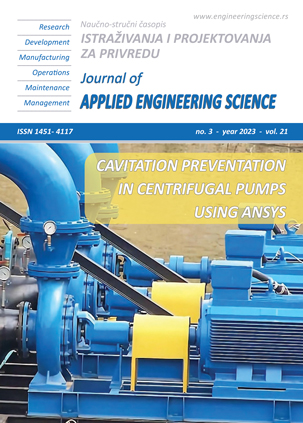GENDER DIFFERENCES IN TRAFFIC RISK BEHAVIOR AMONG MOTORCYCLISTS IN INDONESIAN CITY
Abstract
Several factors, such as humans, vehicles, roads, and the environment, can cause traffic accidents. However, studies have shown that the crucial problem in traffic accidents is the human factor, in particular motorcycle users, or motorcyclists. This study aimed to investigate the traffic risk behavior of motorcyclists’ considering gender as a factor to reduce traffic accidents. The data was obtained through a self-administered questionnaire completed by 155 motorcyclists in Aceh Province, Indonesia, specifically in Banda Aceh City and the neighboring areas. The questionnaire included information about the characteristics of the respondents as well as their perceptions of traffic risks. The data collected were analyzed using Chi-Square test/Fisher’s Exact Test, and Odds Ratio (OR). According to the findings, gender had no significant effect on motorcyclists' traffic risk behavior among the eight variables considered (overtaking, speeding, the use of cell phone, turning without signal alert, tailgating, the use of helmet, helmet strapping, and the use of protective cloth). Subsequently, it was observed that not using helmets while riding put men at greater risk than women. The odds ratio of 3.930 implies that men who frequently drive without helmets have a 3.930 times higher risk of traffic accidents than women. The study revealed that, although gender did not affect traffic risk behavior, men were more at risk than women in almost all categories except tailgating. As a result, male motorcyclists are required to be more responsible when driving, and local governments must play a key role in law enforcement to decrease traffic accidents.
References
World Health Organization (WHO). Violence and Injury Prevention: Road Traffic Injury, from http://www.who.int/violence_injury_prevention/road_traffic/en/, accessed on 10.08.2019.
Anggraini, R., Sugiarto, S., Pramanda, H., (2017). Factors Affecting Trip Generation of Motorcyclists for the Purpose of Non-Mandatory Activities. AIP Conference Proceedings 1903, p.060011-1 – 060011-7.
Joewono, T.B., Vandebona, U. & Susilo, Y.O., (2014). Behavioral Causes and Categories of Traffic Violations by Motorcyclists in Indonesian Urban Roads, Journal of Transportation Safety and Security, vol. 7, no. 2, 174-197, DOI: 10.1080/19439962.2014.952467
Suthanaya, P.A., (2016). Analysis of Fatal Accidents Involving Motorcycles in Low Income Region (Case Study of Karangasem Region, Bali-Indonesia), International Journal of Engineering Research in Africa, vol. 19, 112-122. DOI: 10.4028/www.scientific.net/JERA.19.112
Joewono, T.B. & Susilo, Y.O., (2017). Traffic Violations by Young Motorcyclists on Indonesian Urban Roads, Journal of Transportation Safety & Security, vol. 9 2017, 236-261. DOI: https://doi.org/10.1080/19439962.2016.1247123
Arifuddin, A., Napirah, M.R., H.S NA. (2017). Risk Factors in Road Traffic Accidents in the City of Palu, Indonesia. Public Health of Indonesia, vol. 3, no. 1, 23-29
Pusiknas, (2022). Journal of Semester I Bareskrim Polri. National Police Criminal Information Center, Criminal Investigation Agency (Bareskrim Polri) Police of Republic of Indonesia.
Banda Aceh City in Figures (2022). Central Bureau Statistics of Banda Aceh City. ISSN: 2541.2525
National Traffic Police Corps Republic of Indonesia (2023). 315 Accident Cases in Aceh during January 2022. from https://korlantas.polri.go.id/news/315-kasus-kecelakaan-di-aceh-selama-januari-2022/ accessed on 2023-02-24.
Alvisyahri, A., Anggraini, R., Sugiarto, S., (2020). Motorcyclist Perceptions on Road Safety Considering Awareness, Riding Behavior, and Risk-Taking Behavior, as Latent Variables. IOP Conference Series, Materials Science and Engineering, 2020, 917(1), 012035
Fadhil, A., Anggraini, R., Sugiarto, S. (2022). Analysis of Motorcycle Rider Errors, Deviations, and Violations in Relation to Safe Riding. (in Indonesian). Jurnal Arsip Rekayasa Sipil dan Perencanaan, vol. 5, no. 1, 203-212 http://dx.doi.org/10.24815/jarsp.v5i1.24681
Hongsranagon P., Khompratya T, Hongpukdee S, Havanond P and Deelertyuenyong N, (2011). Traffic risk behavior and perceptions of Thai motorcyclists: A case study, IATSS Research, Vol. 35, 30–33.
Khan S U R, Khalifah Z B, Munir Y, Islam T, Nazir T, Khan H, (2014). Driving behaviors, traffic risk and road safety: comparative study between Malaysia and Singapore. International Journal of Injury Control and Safety Promotion, vol. 22, no.4, 359-367. http://dx.doi.org/10.1080/17457300.2014.925938>
Siebert, F. W., Albers, D., Naing, U. A., Perego, P., & Santikarn, C. (2019). Patterns of motorcycle helmet use–A naturalistic observation study in Myanmar. Accident Analysis & Prevention, 124, 146–150. https://doi.org/10.1016/j.aap.2019.01.011>
Anggraini, R., Alvisyahri, A., Sugiarto, S., (2021). Perceptions of Motorcycle Riders' Safety Against Traffic Violations and the Completeness of Safety Attributes in Banda Aceh City. (in Indonesian). Jurnal Teknik Sipil ITB, Vol. 28 No. 3, ISSN 0853-2982.
Government of Republic of Indonesia, (2009). Decree No.22. Year 2009 in Traffic and Land Transport Mode (Undang – Undang Republik Indonesia No. 22 Tahun 2009 tentang Lalu Lintas dan Angkutan Jalan, Jakarta
Minister of Transportation Government Regulation No. 79 of 2013 concerning Traffic Networks and Road Transportation in Indonesia, Jakarta
Iamtrakul, P., Tanaboriboon, Y., Hokao, K. (2003). Analysis of motorcycle accidents in
developing countries: a case study of Khon Kaen, Thailand. Journal of the Eastern Asia Society for Transportation Studies, vol. 5, 147–162.
Sugiarto, S., Miwa, T., Sato, H., Morikawa, T., (2020). The Tendency of Public's Attitudes to Evaluate Urban Congestion Charging Policy in Asian Megacity Perspective: Case a Study in Jakarta, Indonesia. Case Studies on Transport Policy, vol. 8, no. 1, 143-152. https://doi.org/10.1016/j.cstp.2018.09.010>
Nimako Aidoo, E., Bawa, S., & Amoako-Yirenkyi, C. (2018). Prevalence rate of helmet use among motorcycle riders in Kumasi, Ghana. Traffic Injury Prevention, vol. 19, no. 8, 856–859. https://doi.org/10.1080/15389588.2018.1509072
Brijs, K., Brijs, T., Sann, S., Trinh, T. A., Wets, G., & Ruiter, R. A. C. (2014). Psychological determinants of motorcycle helmet use among young adults in Cambodia. Transportation Research Part F: Traffic Psychology and Behavior, vol. 26, part A, 273–290. https://doi.org/10.1016/j.trf.2014.08.002
Ahmed, M.B., Ambak, K., Raqib, A., & Sukor, N.S., (2013). Helmet usage among adolescents in rural road from the extended theory of planned behavior. Journal of Applied Sciences, vol. 13, no. 1, 161–166. https://doi.org/10.3923/JAS.2013.161.166>
Oxley, J., O’Hern, S., & Jamaludin, A. (2018). An observational study of restraint and helmet wearing behavior in Malaysia. Transportation Research Part F: Traffic Psychology and Behavior, 56, 176–184. https://doi.org/10.1016/j.trf.2018.03.028

